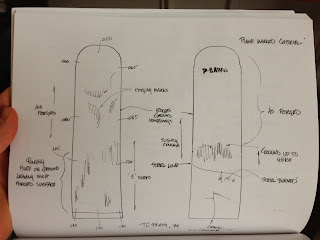Am I the last person to know about this? Lee Valley sells tapered plane blades! Check them out here. Ok so they are shorter than my bench plane blades. That is my only complaint. I really don't know where my head has been stuck. Does anyone know how long these have been for sale? I am currently slapping my forehead and doing back flips all at the same time. All I can do is laugh. Thanks to everyone who has emailed to inform me about these. :)
Original post:
So I have been working on getting some tapered wooden bench plane blades made. You may or may not be familiar with what I am talking about. If you have used a side escapement moulding plane then you are familiar with the tapered blades they have. Well this is no different really.
All the planes I have made up to this point are single iron planes, that is the plane blades have no cap iron, and I have made them with just a flat iron, without any taper. I know that you can make a very good plane with a flat iron but there are some things that are far better with a tapered iron.
Here is just a couple of reasons. One is that the blade is wedged more securely thus vertically eliminating the blade shifting while in use either side to side or backwards. This more secure fit really reduces and chatter that could result from less than ideal fit from normal seasonal wood movement.
The biggest advantage I believe is that when the back of the blade is maintained flat during sharpening a taper toward the heel of the blade keeps the blade form actually becoming a taper toward the cutting edge on a flat blade since it is being reduced in thickness on that end. This would of course result in a blade that shifts backwards in use and becoming loose. Along with that issues is that a flat blade seems to change position more when setting the wedge while a tapered one doesn’t. This seems contrary to what you might imagine. I could go on but I think you are probably seeing the value of a tapered blade so far.
While researching how to machine these blades and just before I was about to go on a buying spree for more tools (metal working stuff; milling machine, surface grinder, etc.) I met a retired machinist in his eighties that convinced me to let him produce them for me. I think I am glad that I agreed if not for the very fact I know they will be right the first time and that I can get the blades I want in a reasonable amount of time and on to making the planes I want to make. After all I am a woodworker first, the metal work is something I would like to learn but I need to stay focused as much as I can. After all the original blades for these antique 18th century planes would have been blacksmith made.
Speaking of that, I am basing the blades on the single iron plane blades that are shown in "The Tool Chest of Benjamin Seaton" 2nd Edition. They are from a british plane found in a tool chest from 1797. Thank you to blacksmith Peter Ross for getting me to the proper historically accurate blade design.
I want to thank Raney Nelson of Daedtoolworks for getting me on the right track for getting these machined in the correct fashion. That is to say the right machines and the right tooling.
Here are a few photos of the process and the results so far in our test material. I hope to have the actual blades cut, shaped and in my hands next week! Then they will be off for heat treating.
Stay tuned!






For what it is worth, they only showed up on LV at most a couple of weeks ago - they are still listed as 'New'
ReplyDeleteGood to know. I was beginning to wonder where I have been. I have there current catalog and never found it in there. Thanks for the info.
Delete